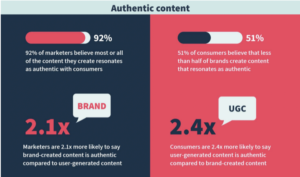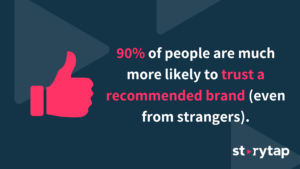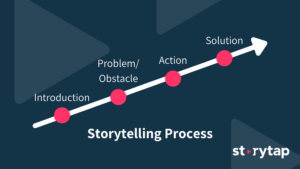Once upon a time, in an era long gone, brands used nothing but logos, jingles, and studio-produced clips of actors to create branded video content. The idea was to showcase a picture-perfect scenario featuring their product or service.
Today, people value people and emotions. Shiny studio-produced ads are losing their sheen. With a sea of products and brand material showing up on web browsers, social media feeds, and in their inboxes every day, consumers want more realness from brands. Many brands think they’re producing genuine content that speaks to their audience, but stats prove otherwise (see this myth-buster infographic on what consumers want vs. what marketers believe).

The key to connecting with consumers (and earning their trust) is to appeal to their emotions. Shoppers aren’t numbers; they’re humans, and we are emotion-powered creatures at our core. In fact, the majority of our purchase decisions are in fact driven by our emotions and subconscious, according to a Harvard researcher. It’s critical to elicit feelings in each stage of the consumer journey: attracting people towards your brand (awareness), convincing them to click through to checkout (conversion), and then keeping them as loyal customers (retention).
But how do you stir up the “feels”? Enter digital storytelling, a sure-fire way to better attract, engage and connect with consumers.
What is Digital Storytelling?
Digital storytelling is similar to regular storytelling, the key difference is that it is in a digital format whether that’s a video, gif, podcast, or audio clip. In the marketing and eCommerce world, digital storytelling will generally go hand-in-hand with user-generated content (UGC): real people sharing their experiences with a brand, its offerings, or an employer. Here are just a few examples of stories:
- Someone with severe acne sharing their journey to clear skin
- A mom speaking about the products that made her life easier with a newborn
- An employee talking about what they love most at their workplace
- A couple talking about how they fell in love after meeting through a dating app
Video stories can range in tone and style. Here’s an example of a video story about a woman whose life was positively impacted by a cat litter box robot.
And here’s a powerful testimonial for LifeLock.
Why Is Storytelling Important in the Digital Era?
Storytelling also falls under the category of word-of-mouth marketing, which is extremely powerful. Consumers trust other consumers more than the brands they buy from. In fact, we know that 90% of people are much more likely to trust a recommended brand (even from strangers). It goes without saying that it’s much easier to trust someone who isn’t trying to sell you something. Brands have a tremendous amount to be gained by enabling their own customers to share their stories.

When customers produce their own videos to explain how they feel about products, other consumers feel they are generally telling the truth, especially when they can sense real emotion as part of their story. In a digital era, stories are key to forming brand trust and building your community.
Storytelling is useful because it:
- Powerfully grabs people’s attention
- Connects your brand with your audience
- Explains things in a human way
- Displays human emotion
- Is memorable
- Is an effective form of word-of-mouth marketing
The Storytelling Process
There are lots of different storyline structures, but most stories will introduce a problem or obstacle, describe it in detail, then present a solution.

If you’re a brand trying to gather stories about your product or service, start imagining what your customers’ storylines would look like. Ask yourself:
- Who is our customer? Get a solid and detailed, from age to lifestyle to income. Tip: You can use analytics to measure your website or social media community and discover more about them.
- What is the problem or challenge our customers might have struggled with before discovering our brand?
- What are the emotions they must have felt?
- How did they find our brand?
- What kind of hesitations did they likely face before committing to trying our product or service?
- What do they like most about our product or service?
- Would they recommend our product to a friend?
These questions will help you envision the type of stories you’ll produce for your brand, and many of these questions above can actually be reframed as interview questions in order to produce authentic, emotional responses from your customers. Find out more about questions to ask your customers for authentic testimonials.
Storytelling Strategy
What makes a good story? Generally speaking, there are a few qualities that all of the best ones have. They are:
- Relatable: People can see themselves in the main character or at least understand and empathize with their emotions.
- Real: They feel authentic and genuine, not scripted.
- Engaging: Viewers want to know how it will end.
Find more tips on how to turn your own customers into creators and create compelling stories.
Storytelling Technology
While some brands will turn to studio production, the other option is to allow for “realness” even in format and filming. In comparison to high-budget videos, these videos feature real people in their real spaces. They’re created on mobile devices or laptops, without the perfection of most branded videos—intentionally.
How can a brand produce these genuine, impactful video stories? Enter StoryTap’s patented video engagement platform. Those are a lot of words, but it’s actually super simple: a user-friendly platform (along with customized storylines) creates video stories from consumers or employees—at scale, in any language, for any demographic. The end result is authentic video content like product reviews, self-service videos (where FAQs are answered by staff), testimonials, and more. Plus, all videos include SEO metadata and are fully brand-controlled and free to share across multiple channels (including social media), and easily embed on your site.
With StoryTap, brands can cut production costs by up to 94% (according to StoryTap client ROI). It’s a cost-effective and high-performing way to build up your video content library while keeping your content authentic and impactful.
Book a free demo today to find out more.


